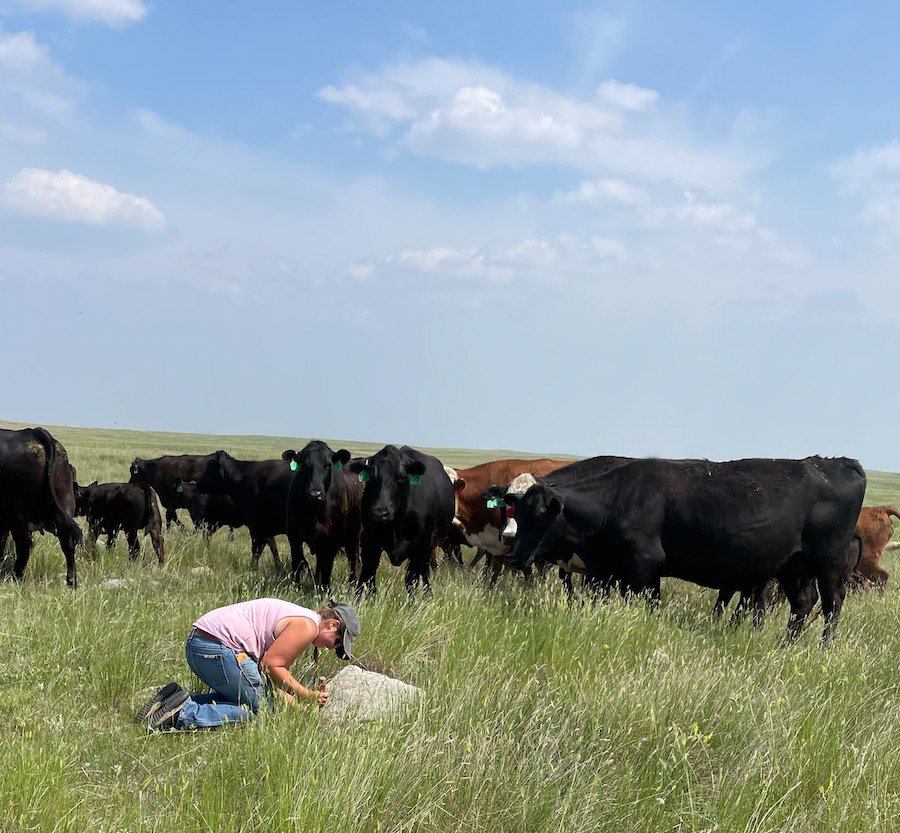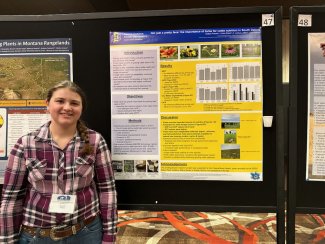
In South Dakota, half of the state's approximately 50 million acres are considered rangeland and provide the grazing area needed for more than 4 million beef cattle. South Dakota is also home to a diverse range of native plants and wildflowers, scattered throughout the state. What is the relationship, if any, between wildflowers and grazing cattle?
According to novel research from South Dakota State University student Kaitlyn Preszler, rangeland with areas of high wildflower diversity is better for cattle than areas with only grass.
"Wildflowers are providing a high nutritional source for grazing cattle," Preszler said. "These wildflowers provided more nutrition to cattle than other feed options, like pre-bud alfalfa, corn, silage and vegetative brome."
Preszler, a wildlife and fisheries sciences and ecology and environment sciences major with a specialization in rangeland management, grew up on a cow-calf operation outside of Roscoe, South Dakota. There, she gained an appreciation for rangeland and livestock production, and after enrolling at SDSU, she decided she wanted to conduct research on the relationship between cattle and wildflowers in South Dakota.
While Preszler knew that wildflowers, also referred to as forbs, made up a significant portion of a grazing cow's diet and could potentially be providing high nutritional value, there had been no prior studies backing up these claims. After winning the first ever Pasqueflower Award from SDSU's Native Plant Initiative, she was afforded the opportunity to investigate herself.
Working with her research advisers in SDSU's Department of Natural Resource Management — Krista Ehlert, assistant professor and an SDSU Extension range specialist; Lora Perkins, associate professor; and Joshua Leffler, associate professor — Preszler studied the nutritional value, neutral detergent fiber and dry matter digestibility of individual forb species native to South Dakota.
"We selected wildflower species that were widely distributed throughout South Dakota," Preszler said. "Selections were made by looking at scientific literature that documented cattle selection preferences or species that were often questioned by producers."
The various forb species were grown in greenhouses on campus. Once an adequate amount of dry matter was grown, digestibility tests were conducted.
"The tests were able to find the percentage of the plant that is indigestible to cattle," Preszler said. "We then compared these results to other feed options used throughout South Dakota. We compared our results among the different species to see if some were statistically better than others."
The results indicated that forbs are a high nutritional source for grazing cattle. All the species were highly digestible and had high nutritional values. The relative feed value range of 215 to 245 indicated a high-value forage for the native wildflowers.
"Although all species tested had high nutritional value, statistical differences indicated that certain species may be more valuable than others," Preszler said.
For example, the prairie cinquefoil, a native South Dakota wildflower, was more digestible than purple coneflower, another native wildflower.
"The results from this study suggest that wildflowers provide producers with an important source of nutrition and thus have economic value," Preszler said. "The biggest takeaway was that wildflowers are providing a high nutritional source for grazing cattle, which means that areas with high wildflower diversity are more valuable than monocultures."

With the study's results in hand, Preszler's future plans are to work with private landowners through federal or state agencies to implement conservation practices in their ranging operations.
“This is groundbreaking work that provides landowners and ranchers with important information," Perkins said. "Kaitlyn (Preszler) has exceeded expectations with her work with the Native Plant Initiative.”
Preszler's research will be featured at the 2024 South Dakota Student Research Poster Session on Feb. 29 at the State Capitol. Her work was supported by SDSU alumna Rebecca Kurtz Schwanke and her husband, Steve, who endowed the Pasqueflower Award to support undergraduate research with the Native Plant Initiative.
- Contact:
- Telephone number: 605-688-6161
Republishing
You may republish SDSU News Center articles for free, online or in print. Questions? Contact us at sdsu.news@sdstate.edu or 605-688-6161.

